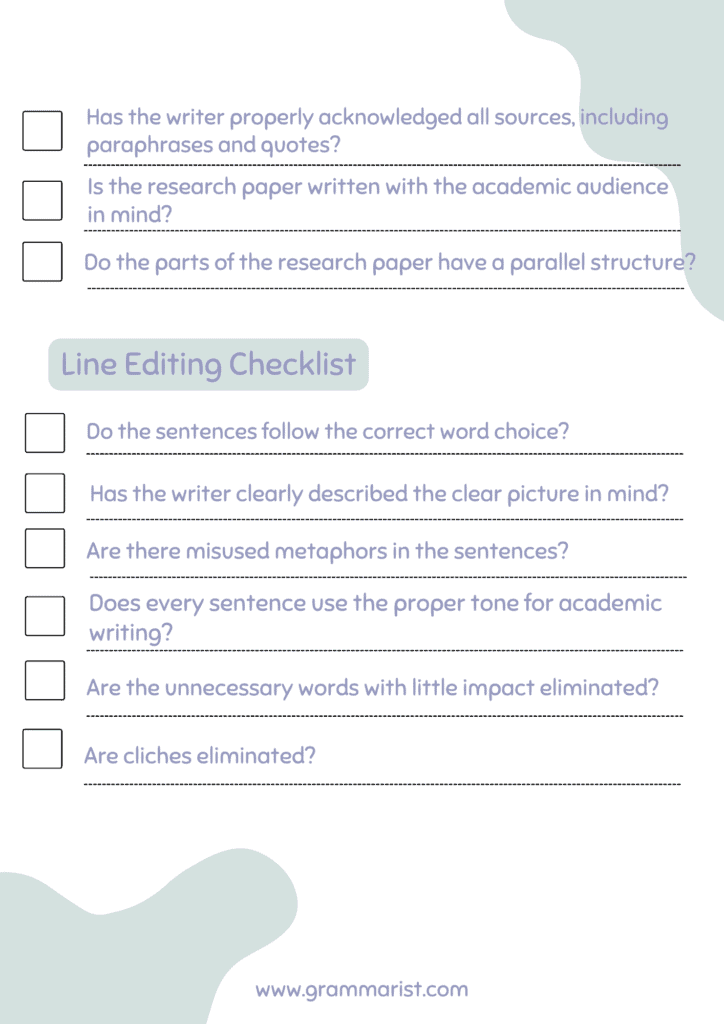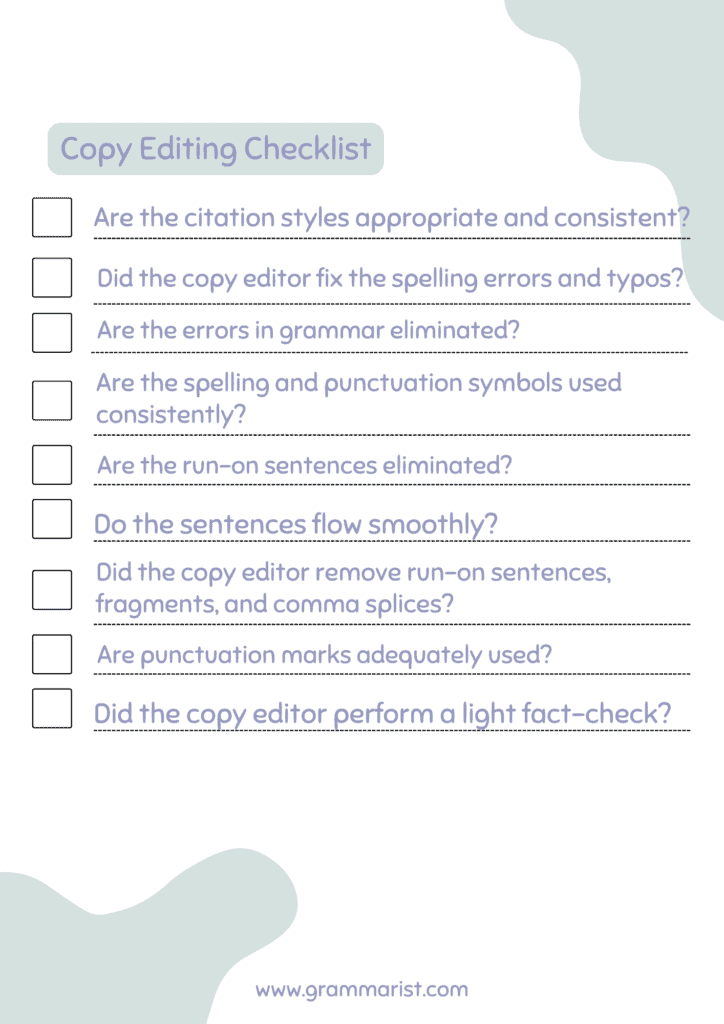Writing a research paper requires more than correcting language errors, such as spelling and grammar mistakes. You must also ensure everything is factual and parallel to academic writing standards. I wish I’d known that when I was in university; it would have saved me a lot of headaches.
So, when editing your paper, what should you focus on? Over time, I learned a few things, and I will share them with you! Follow these tips to ensure your research paper is prepared for research publication. I also provided a checklist of everything to consider during the process.
What is the Importance of Editing in Research?

Take it from me, no matter what you’re writing, professional editing is always necessary for your documents. You might not notice the spelling errors and lack of substance in your literature review right after the writing process. That means you should read it several times to edit it.
Editing your research draft is essential to maintain the credibility of your work. You need to ensure that the academic paper follows an academic tone. As someone who generally writes fiction, I struggled with this. But, over time, I learned how to switch between the two.
Such a tone does not require the writer to relate to the readers. Instead, academic editing aims to convey the acquired knowledge in a particular field.
What are the Steps in Editing and Proofreading a Research Paper?
To produce a research paper that is impactful to the academic discipline, you must edit and proofread it at multiple levels.
- Determine your editing purposes. Identifying your objectives will help you pick the appropriate approach and tools for the editing process.
- Revise paper. Examine the main point of your research paper and your evidence. Check if the body supports your thesis and if everything is properly cited.
- Make the edits. In this step, you should conduct the grammar and spelling check. Look for contextual errors and tonal inconsistencies too.
- Look for plagiarism. Use software programs like Scribbr or Turnitin to perform a plagiarism check.
- Follow the established style guide. Check if the research article follows the preferred style guide, whether APA, AP, MLA, or Chicago.
- Proofread. The proofreading phase looks for errors previously missed before publishing.
Top Tips for Editing Your Research Paper

Once you know the basic steps to editing a research paper, here are my tips to make your life easier. These work for me and not only helped me produce quality papers, but even cut down the time it took to produce them.
Choose Your Preferred Method of Editing
Your editing efforts should be structured and organized so you can develop a stable process of editing.
You already know that you edit from the bigger picture to minor details like grammatical errors and punctuation errors. But you have to decide your specific strategies. Will you be hiring a proofreading service? Which resources and tools will you use?
An ideal editor knows how to perform revisions and edits on different programs. For instance, Grammarly might help you with run-on sentences, while Hemingway can help with conciseness. I’d suggest you use both in tandem.
Find an Environment Where You Can Focus
Any professional editor will tell you the importance of a serene workplace for a good editing experience of book manuscripts and research papers. It will keep your mind focused on all aspects of writing, including spelling and grammar checks.
A clean desk and proper lighting will also help you notice more significant writing mistakes. Remember to take a break in between aspects of writing.
For me, it was the public library. I had a loud roommate, and we lived in an old Victorian home that was poorly converted into apartments, so I always heard the neighbors making noise. It was near impossible to concentrate. So, after classes were done for the day, I’d head to the library for a couple of hours to get the bulk of my research and editing done.
Focus on One Editing Issue at a Time
Many university students find the editing processes an arduous task because they try another editing approach while not yet finished with one. The reason we need to follow several steps to editing is to avoid confusion.
Once I learned this tip, it was smooth sailing. Yes, it sounds like more work, but it’s really not. When scanning a document for several types of issues, you’re more likely to miss things. So, scan for one issue at a time, and you’ll actually do a better job in less time. Trust me.
Focusing on one at a time will help you spot the huge and minor errors on the entire document. It also allows you to spot both English-language errors and contextual errors in the research paper.
Make Sure All of Your Work is Accurate
Accuracy is a crucial factor in editing any English manuscript. Aside from checking the elements of grammar, the journal editor should also check the facts the author is writing. Sometimes, they might perform additional editing to correct errors previously missed.
The biggest difference between proofreading and editing is that proofreading looks for mistakes that previous copy editors didn’t spot. They look at all aspects of writing to make the perfect paper before publication.
A proofreader might need a checklist of key questions to look for, from spelling to punctuation errors.
Don’t Always Rely on a Grammar Checker
An online grammar checker won’t be able to replace qualified editors and their complex tasks throughout the editing process. Yes, it’s a great tool to help the process, but don’t rely on it wholly.
Some artificial intelligence apps can detect improper tone based on the target audience you set. Others can even help with your sentence structure and writing styles. But they can’t help you with producing a smooth flow of ideas.
Tools like Grammarly, ProWritingAid, and Ginger won’t help you with the manual revision process. Only your human judgment can decide how excellent your points are. You need to check whether the abstract of your academic document is complete with the necessary info.
Don’t Make These Super Common Mistakes in Research Paper Editing
Here are some research paper editing mistakes to avoid. You’d be surprised how many people do these.
Changing the Research Questions or Problem
Your editing objectives for your research paper should not include changing one research question or problem. Otherwise, you will be in huge ethical trouble for manipulating the findings.
Expert editors agree that the methods of editing a research paper only include following an academic writing style guide and making the paragraph structure logical. You may change a few words on the findings to produce quality writing. But never change the numbers.
It’s not enough that you know common language errors and editing stages. Proper editing requires knowledge of the ethical guidelines when research editing.
Using Ineffective Keywords
Qualitative research paper editing entails using appropriate keywords in the paper draft. It’s a common issue in subject-area editing since many writers and editors overuse or underuse keywords.
Content editing is one of the stages of editing that looks at the style of writing, institutional needs, and more to lift it to a publishable standard. Pick only four to six words that frequently recur throughout the paper.
Not Fixing the Format
Your task is not just to perform editing for revision. It’s not enough for the editor to re-write sentences, conduct a spelling check, or fix style errors. The copy editor, proofreader, and format editors should have enough editing practice to fix formatting issues.
These stages of writing include aligning the paragraphs appropriately and formatting the citations according to the style guide. Font style, page numbers, and paragraph breaks will help you create an impactful research manuscript.




Enhance Your Editing Efficiency
Editing is a systematic endeavor. Whether you’re a college, university, or graduate student, I hope this article gives you tips for editing your research paper.
Remember to edit your paper more than once. Start from the bigger picture issues until the minor details like misspellings and grammar slip-ups. Use the editing checklist above to revise, edit, and proofread your academic document.
